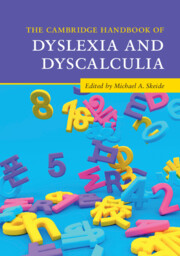Book contents
- The Cambridge Handbook of Dyslexia and Dyscalculia
- The Cambridge Handbook of Dyslexia and Dyscalculia
- Copyright page
- Contents
- Figures and Tables
- Contributors
- Acknowledgements
- General Introduction
- Part I Theoretical Frameworks and Computational Models
- Part II Cognitive Profiles and Behavioural Manifestations
- Part III Genetic and Environmental Influences
- Part IV Neurodevelopmental Foundations
- Part V Gender, Ethnicity, and Socioeconomic Background
- Part VI Cultural Unity and Diversity
- Part VII Early Prediction
- Part VIII Intervention and Compensation
- 19 Randomized Controlled Trials in Dyslexia and Dyscalculia
- 20 Cognitive Enhancement and Brain Stimulation in Dyslexia and Dyscalculia
- 21 Persistence and Fade-Out of Responses to Reading and Mathematical Interventions
- Summary: Intervention and Compensation
- Part IX Best Practice – Diagnostics and Prevention
- Part X Best Practice – Schooling and Educational Policy
- General Summary
- References
- Index
Summary: Intervention and Compensation
from Part VIII - Intervention and Compensation
Published online by Cambridge University Press: 28 July 2022
- The Cambridge Handbook of Dyslexia and Dyscalculia
- The Cambridge Handbook of Dyslexia and Dyscalculia
- Copyright page
- Contents
- Figures and Tables
- Contributors
- Acknowledgements
- General Introduction
- Part I Theoretical Frameworks and Computational Models
- Part II Cognitive Profiles and Behavioural Manifestations
- Part III Genetic and Environmental Influences
- Part IV Neurodevelopmental Foundations
- Part V Gender, Ethnicity, and Socioeconomic Background
- Part VI Cultural Unity and Diversity
- Part VII Early Prediction
- Part VIII Intervention and Compensation
- 19 Randomized Controlled Trials in Dyslexia and Dyscalculia
- 20 Cognitive Enhancement and Brain Stimulation in Dyslexia and Dyscalculia
- 21 Persistence and Fade-Out of Responses to Reading and Mathematical Interventions
- Summary: Intervention and Compensation
- Part IX Best Practice – Diagnostics and Prevention
- Part X Best Practice – Schooling and Educational Policy
- General Summary
- References
- Index
Summary
(1) Quality criteria for effective intervention: There is evidence that interventions are most effective when they are individualized, adaptive, embedded into 1:1 or small group settings, focused on multiple domains, and start as early as possible. The slightly lower effect size of computer (vs. in-person interventions) should be balanced against their potentially wider applicability.
- Type
- Chapter
- Information
- The Cambridge Handbook of Dyslexia and Dyscalculia , pp. 378 - 380Publisher: Cambridge University PressPrint publication year: 2022

